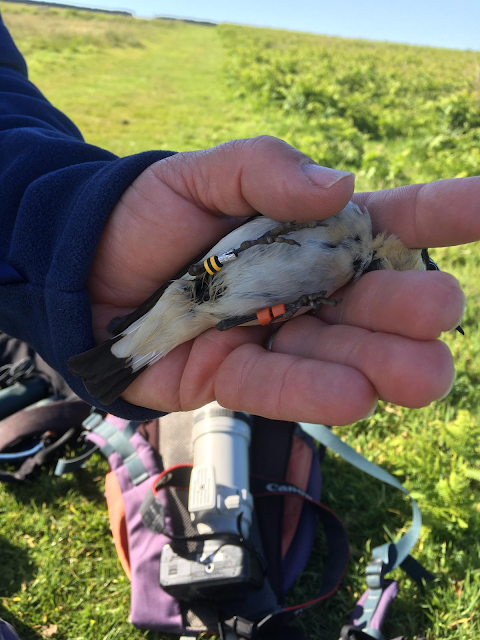Overcast and cold at the start of the week, brightening by Friday when winds shifted from the west to the northeast.. The end of the week had clear skies and temperatures peaking at 15°.
Even though there are few migrating birds, the island is very noisy at the moment with numerous hungry mouths to feed. In Millcombe Wrens, Blackbirds, Robins, Chaffinches and Dunnocks all have fledged chicks to feed. In the Gorse and fields the first young Linnets and Meadow Pipits have fledged. The loudest chicks are the Starlings which are calling from everywhere in the Village.
 |
| Juvenile Chaffinch, Millcombe © Stuart Cossey |
 |
| Juvenile Starling, Village © Stuart Cossey |
A small passage of Swift was noted in the northeasterlies with two on the 28th and 12 on the 29th. The Collared Dove remains in Millcombe, often singing from the top of Millcombe Woods. A Cormorant flew north over the Battlements on the 28th before changing course and heading west over the island.
The warmer weather towards the end of the week was typical for migrating birds of prey and as expected an Osprey flew low over the East Coast on the 27th mobbed by the local gulls and Peregrine. A Hobby was seen heading north over Ackland’s Moor on the 28th and two Merlin were reported on the 27th. The Kestrel pair are doing well with the male often seen taking prey items back to the nest on the West Coast.
Small numbers of hirundines continue to migrate over the island. One Sand Martin was seen on the 23rd, two on the 26th and 27th and three on the 29th. House Martins were every day with a peak of eight on the 23rd and 27th. High counts of Swallows were 30 on the 27th and 36 on the 29th.
The majority of warblers on the island at the moment are the local breeding birds. A pair of Blackcap and at least three singing Whitethroats are in Millcombe. Willow Warbler were seen on 23rd to 25th and 28th and 29th including a few singing males. At least one Chiffchaff is singing in Millcombe with others seen along the East Coast.
A Golden Oriole was first seen on the 24th at the bottom of Smelly Gully before flying to St Helens Copse. It then gave some brief views in the Sycamores above Millcombe House on the 25th. The final sighting was on the 27th as it flew east down Millcombe Valley. It was identified as an immature male given its greener plumage.
Spotted Flycatchers were seen up to the 28th with a high count of six on the 26th. A male Black Redstart was seen on the 27th and 28th. A Yellow Wagtail was still in Barton Field on the 23rd and two males including a Blue-headed Wagtail were there on the 29th. Two White Wagtails were recorded on the 23rd and a single was present on the 27th.
 |
| Spotted Flycatcher, Millcombe © Stuart Cossey |
A group of ringers are currently on the island colour ringing our breeding Wheatear. This allows us to work out where they breed each year and how old they are without having to catch them. If you do see any colour ringed Wheatear please make a note of the sequence or take a photo and email assistantwarden@lundyisland.co.uk
 |
| Colour ringing Wheatear, West Coast © Rebecca Taylor |
Contributors:
S Cossey, R Ellis, Z Wait, L Pirateque, J Dunning, P Holt, J Holt, C Clabburn,
P Blabburn, S Long, R Taylor, M Port
No comments:
Post a Comment